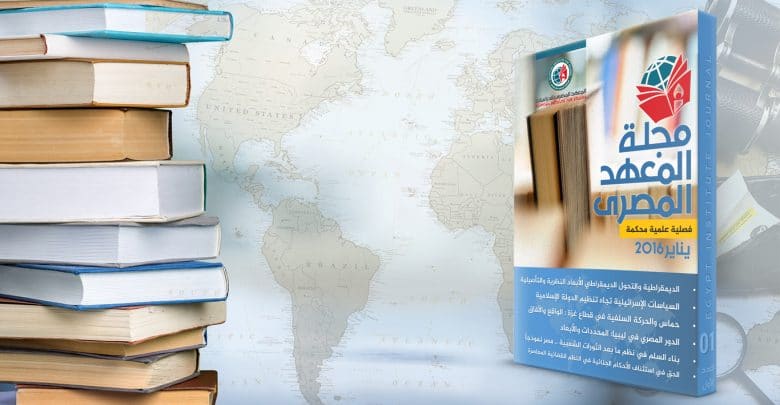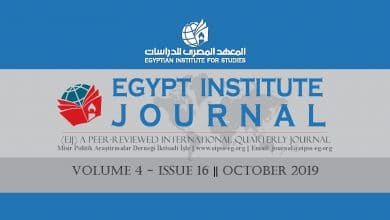
About Egypt Institute Journal
Profile:
Egypt Institute Journal A peer-reviewed international quarterly journal, published by the Egyptian Institute for Studies (EIS),
specialized in publishing researches and studies in social sciences and humanities
The Egypt Institute Journal adopts the formal and objective specifications of international peer-reviewed journals, according to the following:
First: Articles submitted to EIJ should be an original research paper that has not been previously published or submitted for publication elsewhere, in part or in whole, or even a similar topic, in any electronic or paper publishing medium, or presented in a scientific conference other than the conferences held by the Egyptian Institute of Studies (EIS), or to any other party. The main researcher makes a signed commitment along with all participating researchers (if any) stating that the research has not been previously published or submitted for publication, and that it will not be submitted for publication later in another journal until the review process ends with rejection of the article. After the article is accepted for publication, all copyright belongs to the Egypt Institute Journal.
Second: The writer’s academic biography should be attached with the article both in Arabic and English.
Third: The article should include the following:
1) The article’s title both in Arabic and English.
2) A brief biography of the writer and the academic institution to which he belongs as well as his latest articles that have been published, whether in Arabic or in English.
3) An abstract of 100-125 words in Arabic and English.
4) 3-8 Keywords immediately after the abstract.
5) The basic elements of the theoretical, methodological, and conceptual framework, including: the study problem, objectives, significance, critical review of previous literature, study questions, hypotheses, the methodology or approach used, and the findings.
6) A bibliographic list of references, including the references that the writer relied on, in addition to the basic references that he benefited from but did not mention in the footnotes. The research data shall be included in the list in their original language in case of using references from several languages.
Fourth: Writing controls
1) The article should be within the scope of the journal’s goals and interests.
2) The journal is interested in publishing critical reviews of important books that have recently been issued in its areas of competence in both Arabic and English, provided that they have not been published more than three years ago. The size of reviews should range from 4,500 to 5,000 words and will be subject to peer-reviewing according to the Egypt Institute Journal rules.
3) The size of the article, including footnotes, references, tables and annexes, if any, should range from 6000 to 8000 words.
4) Charts, diagrams, equations, graphs or tables should be sent in Excel or Word, and the diagrams, drawings, and tables that are send as pictures shall not be accepted.
5) Manuscripts should be submitted as a MS Office Word file, with margins of 2.5 cm all round (top, bottom and both sides of page). Line spacing should be set to single spacing.
6) All text should be typed in “Simplified Arabic” for Arabic texts and in “Times New Roman” for English texts and the font size for both should be 14, and 10 in footnotes.
7) Arabic figures (1-2-3 … Arabic) should be used in all text.
8) The numbering of pages shall be in the middle of the bottom of the page.
9) The title of the article, the name of the researcher or researchers, the institution to which he belongs, and the address should be written on a separate page before the article pages, starting from the first page where the title of the article is written followed by the entire article.
10) It should be noted that the article must not include the name of the researcher, or researchers, in the body of the article explicitly, or by any hint that reveals his surname or surnames, but only the word (researcher or researchers) can be used instead of the name, whether in the text, referencing, or in the bibliography.
11) If the study is accepted, an official letter will be sent to the researcher, indicating acceptance of the study, and the publishing date.
12) In the event the referees committee recommends that the researcher should make specific amendments, the researcher must deliver the article after making the recommended modifications within a period of 15 days from the date of sending the amendments. If the researcher delays in submitting the required amendments, or does not make them, the referees committee has the right to reject the article.
13) After manuscripts are accepted for publication, all copyright belongs to the Egypt Institute Journal; and it must not be published anywhere else, whether in paper or electronic media outlets, without written permission from the journal’s administration.
14) The opinions and views expressed in the published articles express the views of researchers only, and do not necessarily express the opinion of EIJ.
15) The Editorial Board has the right to set priorities for publishing research.
16) The research papers shall be submitted electronically through the journal e-mail: [email protected]
Fifth: Referencing
The researcher adheres to the following controls when writing references and sources of the article.
(1) Books
Author’s name, book title, translator or editor name, edition (place of publication: publisher, publication date), page number.
The book is cited in the following non-respective reference as follows: the author, op. cit., p.
If there is more than one reference to the same author, then this form should be used: the author, the title, op. cit., p.
The book is cited in the following subsequent reference directly as follows: ibid., P. 118.
(2) Periodicals
The author’s name, study or article title, journal name, folder and / or issue No. (year of publication), page number.
(3) Newspapers and magazines
Author, title, newspaper name, place of publication, date of publication, page if available.
(4) Electronic publications
Author’s name, article or report title, website, date of publication (if available), access date, short link.
(5) Conference and seminars papers
The researcher’s name, research title, conference title, conference venue, conference date, page.
Sixth: Review
Each research/article is subject to a completely confidential review, carried out by two referees who are specialized in the subject of the research, who have academic and scientific experience of what has been accomplished in its field, and who are accredited in the list of the EIJ referees. The journal is obliged to provide the researcher with its final decision: (publishing) (publishing after making specific modifications) (apologizing for not publishing) within two months of receiving the study.
Seventh: Privacy
The journal is morally bound to respect writers’ privacy, confidentiality, and objectivity, and non-disclosure by editors, referees, and members of the editorial board of any information regarding the research referred to them to anyone other than the author, referees, and the editorial board.
Eighth: International documentation
- The Egypt Institute Journal obtains an internationally recognized identification number, Digital Object Identifier (DOI) as a documented reference number for the published study in the international information network and sites that facilitate its spread on search engines, facilitate citation, and documents number of quotes.
- The magazine obtains the international filing number the International Standard Book Number (ISBN) for each edition of the printed and electronic publishing, trading between publishers, libraries, international book fairs, and online book marketing sites.
- The EIJ obtains the International Standard Serial Number (ISSN) for each issue for publishing electronic periodicals, for electronic publication of the journal.
- The researcher receives printed and electronic copies of the edition that includes his article, to be submitted to the academic authorities concerned, and for personal use.
Website: www.eipss-eg.org/category/journal/
Address: Bahçelievler, Yenibosna mah. 29 Ekim Cad. No: 7 A2 Blok 3 Plaza, Kat: 6, D: 64, Istanbul, Turkey. Mobile: +90 5466624446 Tel: +90 2122272262 Mail: [email protected]




